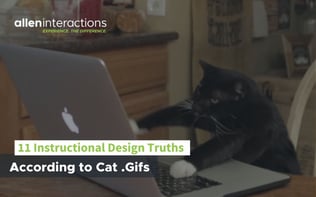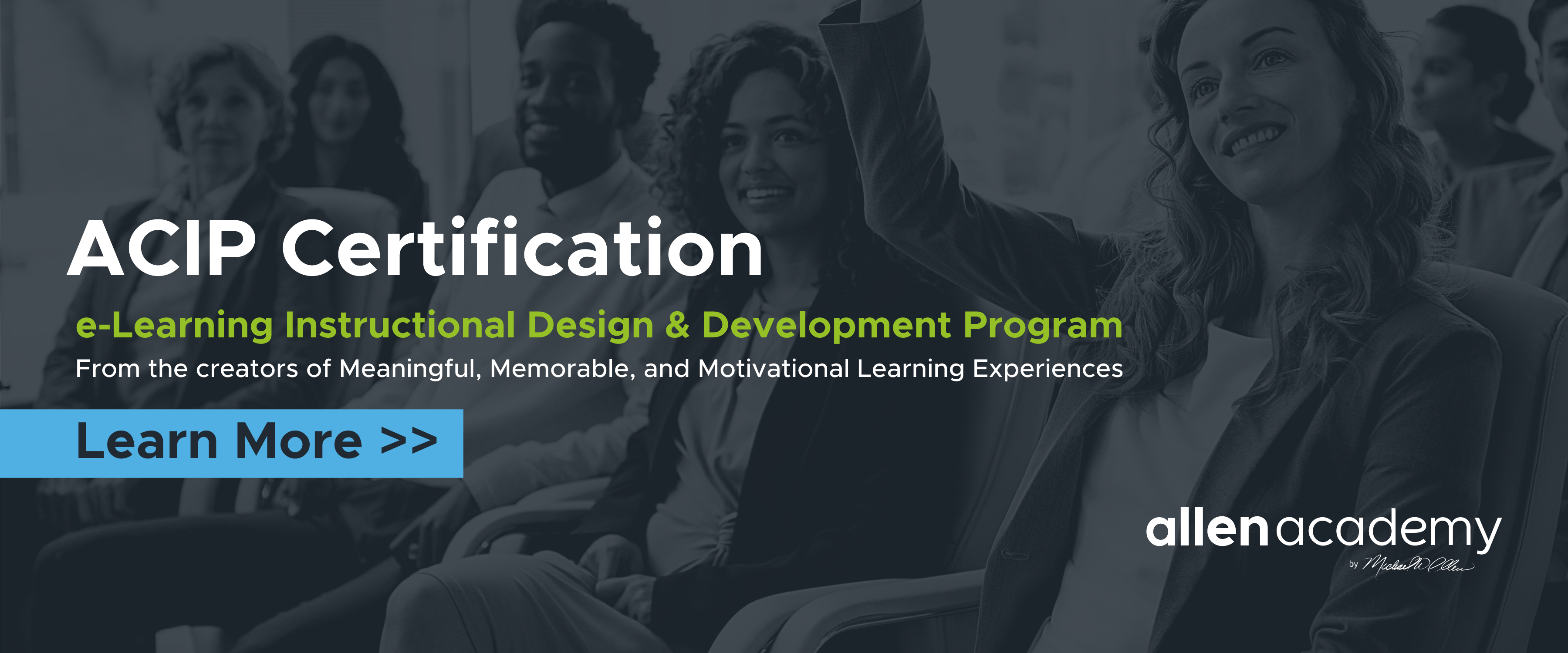Blog
11 Instructional Design Truths According to Cat .gifs
With so many fascinating topics in our world of learning design (mobile learning! MOOCs! Gamification!) we forget to discuss the sticky, ambiguous ...

.png?width=1387&height=526&name=Services%20-%20Blog%20Update%20Pictures%20(2).png)
The Ethics of Instructional Design
By Edmond Manning | April 27, 2017 | Custom Learning | 0 Comments
With so many fascinating topics in our world of learning design (mobile learning! MOOCs! Gamification!) we forget to discuss the sticky, ambiguous issues at the core of our world, topics that don’t have easy answers or a body of research for us to invoke.
I’m specifically thinking of ethics.
As a consultant, I struggle. For example, I wonder whom I serve. My consulting firm? The client who hires us? The learners who depend on us for quality learning? Beyond those considerations, should I prioritize my own integrity as an instructional design professional?
With more than twenty years in our field, I calculated I’ve designed over 200 unique e-learning projects, 30 blended learning events, 50 facilitator-led classes and probably another 50 webinars. For six years, I traveled and taught for ATD. I’ve been on some amazing projects that changed lives, and some projects that did not.
Life is a little more gray when you’re not in graduate school pondering the exciting field of designing for adult learners.
I’d like to share questions which cause me to reflect.

Is this even training?
Many corporations foster a dangerous assumption: if learners aren’t performing as expected, it’s their fault and therefore they must be trained. In truth, there are many reasons for non-performance: lack of reward, obstacles in the environment, management ineptitude, contradictory corporate priorities, etc. Some of these reasons are difficult mirrors. Who wants to admit to inept management? Resolve the organization’s obstacles which stand in the way of performance? No. It’s much easier (and face-saving) to slap together training.
As an ethical instructional designer, how much do I address this? If a stakeholder engages my company and training has already been determined as a solution, should I hold my tongue? Sure, I can advocate for more analysis and suggest we explore various aspects of the performance (and lordy, I have!) but often these are shut down with the words, “We already did that. The solution is training.”
When I’m planning a visit to my mother, and over the phone she asks me which vegetables I’d prefer to go with the pot roast, I’ve learned my response should NOT be, “Who decided on pot roast?”
“Which vegetable?” Mom will ask in a chilly tone. In other words, the pot roast decision is over.
Inappropriately selecting training as a solution has greater ramifications than Sunday dinner. If there’s no analysis to support training, content runs amok. After all, who’s to say what content is enough? With no identified and measured training gap, why not toss a ton of content at learners and see if some sticks? In addition, training must be all-purpose and content-based because learner performance isn’t the core issue. If you don’t bother to pinpoint the problem, you certainly can’t pinpoint a solution.
What if the client doesn’t want to hear, “This may not be a training problem.” What if my own consulting organization doesn’t want me to voice those words? What is the instructional designer’s obligation to bring this up? I usually try to sound out a client’s willingness for this discussion. I ask gentle questions. I cautiously probe the analysis. I ask for data. When I get the chilly business equivalent question of, “Which vegetable?” I work with my team to focus on providing the best learning solution possible.
Should I push harder? I’m not sure that would provide value. Telling the emperor his or her department has no clothes doesn’t end well, especially after you’ve said in four different ways, “I can see through your lack of data.”
Will the outcome be achieved?
Assuming training is the right solution, there are still any number of things that could knock us off track: bad project management, SME interference, vague performance objectives, rigid stakeholders, regulatory groups crashing the party… it’s a long list.
In some ways, the answer is easy: you share potential risks and consequences about everything. The client assumes responsibility. Case closed. But now, let’s visit the real world. When you’re three weeks into a twelve-week project and facing a room full of stakeholders who just announced the project will now change direction, what are the ramifications of raising the red flag? What if you’re confident the project took a wrong turn, but you can’t supply definitive proof?
At some point, the instructional designer becomes ”the professional who cried wolf.” Yet there are so many wolves in the dangerous forest! Are we not the guardians who should be eyes-wide, looking for wolves?
The best solutions I have found include:
- Name the risk. Articulate it. Don’t speak of vague concerns like a bad fortune teller. Get very specific as to the threat.
- Communicate the threat level: low, medium, high. When necessary, say the damning words: “I am not convinced you will achieve the outcomes you want.”
- Offer strategies to reduce this risk. Honestly, you may not have the chance to implement these strategies. But I find clients appreciate a solution offered with the problem, even if they don’t act on the solution.
- Schedule time to discuss the situation again. It’s easy to bring up a project risk and then conveniently forget about it. It is much harder to agree to touch base in two weeks to reassess the risk level.
Will this development process work?
If you splurged mightily and ordered a $100 steak from the organic-certified, grass-fed-cow-who-grazed-happily-and-was-sung-songs-every-night, would you care how it was prepared? Of course. You wouldn’t boil it. You wouldn’t stick it on the grill and run to the store, only to come home and find it burned to a ruined crisp. HOW the steak is prepared heavily influences how successful it tastes at the end.
It’s always a big surprise to me that people who spend $100K on an e-learning project aren’t invested in the development process. Your steak might get burned to a crisp! I do my best to communicate the importance of the development process and what is necessary to guide a training goal to successful delivery. Sometimes, clients listen. Sometimes they even care.
More often, they worry about how their SMEs are involved or how Bob from Marketing will give his input. How do we get Trina from Legal to approve this? While I understand corporate politics and their impact, I must come back to the steak. If you wanted your best friend’s approval of the steak, would you take it off the grill partially done—drive to that friend’s house for visual approval—then drive back home to return it to the grill? No. You would not change the process to fit the approvals you seek. That would be silly.
As the instructional designer, I have no project power. I never have the authority to make decisions. I can voice, “I don’t think this is a good direction. It will disrupt the process.” When I beg to involve learners, explaining the importance of their input at certain stages, I am overridden. With little or no power, my influence boils down to strongly-worded opinion.
How loud do I scream? Do I lose whatever limited influence I have to demand our process is followed without exception? I don’t have an answer. Each unique projects presents its own ethical challenge.
How big should I risk?
I remember one tricky project a few years ago. The clients were also instructional designers. We vibed happily about how most training is awful. We bonded discussing the power of motivation, behavior-based training, and engaging learners through challenges. This was heaven. I had longed for like-minded colleagues to share a vision to create great learning!
Unfortunately, their process for developing our deliverables (both e-learning and instructor-led) would not support the learning outcomes they said they ultimately wanted. We discussed it and I shared my concerns with these like-minded designers. The next day, their organization contacted ours. They had decided not to work with us and ended the professional relationship.
I had been assured by the project manager the relationship fell apart for different reasons. To this day, I am not sure. Our conversation with the client was enthusiastic and respectful. So, what happened? It’s true I was more frank with these folks because I believed we were sympatico. At no point did I say anything unprofessional or extreme, such as, “This will fail.”
When I open my mouth, I have to consider the impact. Will I alienate the clients? Will sharing my concerns draw us closer together? Am I improving the relationship? The solution?
I am not always sure.
I don’t always know.
What’s the risk?
The best we can do
In my not-too-humble opinion, I’m a good instructional designer. I love what I do. I love creating solutions designed to close performance gaps. But even now, after more than twenty-five years designing learning solutions, I still question my ethical responsibilities and their execution. I ponder these questions and how I can best answer them for each project.
I worry about my own performance.
I wish there were some training on this topic.

About the Author: Edmond Manning
Edmond Manning, senior instructional designer for Allen Interactions, has more than 20 years designing interactive e-learning experiences on instructional topics including: software simulation, medical ethics, supervisory skills, and selling/presentation skills, and gosh, a whole bunch of others. He has helped mentor and grow e-learning departments, worked as a business consultant, independent contractor, and instructed the ATD e-Learning Instructional Design Certificate Program for more than a decade. Edmond has a master's degree from Northern Illinois University in instructional technology.
Comments
Would you like to leave a comment?
Related Blog Posts

By: Edmond Manning | Oct, 2019
Category: Custom Learning

Blog
5 Instructional Design Insights from The Marshmallow Test: Part 2
With so many fascinating topics in our world of learning design (mobile learning! MOOCs! Gamification!) we forget to discuss the sticky, ambiguous ...
By: Edmond Manning | Jun, 2017
Category: Custom Learning

Blog
Lessons on Instructional Design from…my Dog
With so many fascinating topics in our world of learning design (mobile learning! MOOCs! Gamification!) we forget to discuss the sticky, ambiguous ...
By: Edmond Manning | Sep, 2016
Category: Custom Learning


